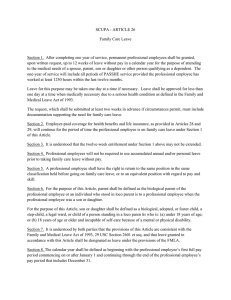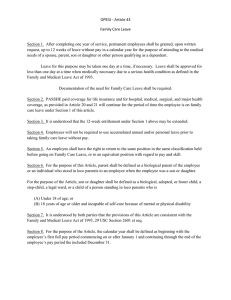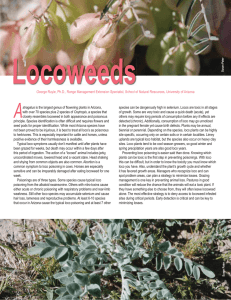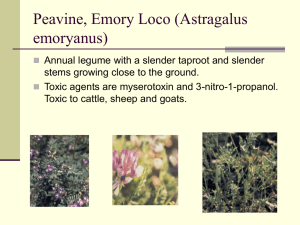THE LOCO WEED AND ITS EFFECT ON LIVE STOCK
advertisement
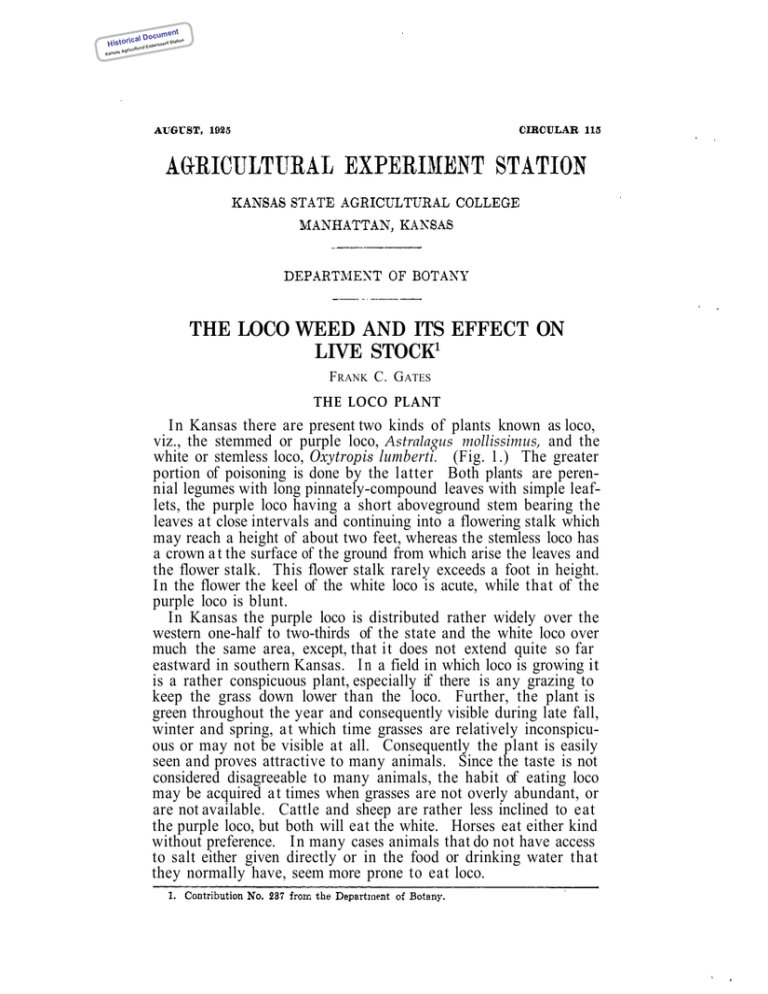
t cumen n cal Do tio Histori ural Experiment Sta Kansas Agricult THE LOCO WEED AND ITS EFFECT ON LIVE STOCK1 FRANK C. GATES THE LOCO PLANT In Kansas there are present two kinds of plants known as loco, viz., the stemmed or purple loco, Astralagus mollissimus, and the white or stemless loco, Oxytropis lumberti. (Fig. 1.) The greater portion of poisoning is done by the latter Both plants are perennial legumes with long pinnately-compound leaves with simple leaflets, the purple loco having a short aboveground stem bearing the leaves at close intervals and continuing into a flowering stalk which may reach a height of about two feet, whereas the stemless loco has a crown a t the surface of the ground from which arise the leaves and the flower stalk. This flower stalk rarely exceeds a foot in height. In the flower the keel of the white loco is acute, while that of the purple loco is blunt. In Kansas the purple loco is distributed rather widely over the western one-half to two-thirds of the state and the white loco over much the same area, except, that it does not extend quite so far eastward in southern Kansas. I n a field in which loco is growing it is a rather conspicuous plant, especially if there is any grazing to keep the grass down lower than the loco. Further, the plant is green throughout the year and consequently visible during late fall, winter and spring, a t which time grasses are relatively inconspicuous or may not be visible at all. Consequently the plant is easily seen and proves attractive to many animals. Since the taste is not considered disagreeable to many animals, the habit of eating loco may be acquired a t times when grasses are not overly abundant, or are not available. Cattle and sheep are rather less inclined to eat the purple loco, but both will eat the white. Horses eat either kind without preference. In many cases animals that do not have access to salt either given directly or in the food or drinking water that they normally have, seem more prone to eat loco. t cumen n cal Do tio Histori ural Experiment Sta Kansas Agricult t cumen n cal Do tio Histori ural Experiment Sta Kansas Agricult EXTERMINATION OF THE PLANT I n order to exterminate loco plants, each plant must be cut off between two and three inches below the surface of the ground with some sharp implement, and the tops disposed of out of reach of the animals. The important thing is to be very sure that no part of the stem or crown remains in connection with the roots, for if it does, it will regenerate the plant. The first year the field will need to be gone over two or three times, and perhaps for two or three years succeeding, the same treatment will need to be given to the field. The labor during these later years, however, will be very much less as the plant becomes more nearly exterminated. This method, if properly employed, is certain to kill the loco plant. Seeds, however, may germinate and develop new plants. These would be gotten by subsequent treatments, and inside of three years the majority would have been accounted for. As the seeds are spread only by the wind blowing them along the ground, a pasture area once thoroughly depleted of its loco is expected to remain entirely or virtually free of loco for a period of approximately eight or nine or more years, depending upon the proximity of plants which might seed into the area. The experience both of agricultural experiment stations and individuals in loco infested areas has shown that this treatment is a satisfactory one. CAUSE OF POISONING While considerable work has been done on loco and loco poisoning, there is as yet no conclusive statement as to just exactly why the loco plant is a poisonous plant. The poison, whatever i t is, is cumulative, that is, a number of apparently ineffective doses are taken before the animal shows any signs of poisoning. Thus an obviously poisoned animal has been eating loco over quite a long period of time. ANIMALS AFFECTED The animals that are usually affected by loco are horses, and to a lesser degree, cattle and sheep. The conspicuous symptoms are a lack of muscular control-trembling, easily startled, more or less paralysis and dull spells. Horses are very nervous, but in sheep the lack of muscular control is not so marked. An animal that has fallen arises with great difficulty. While the animals that die may do so by accident, such as falling in positions that break the neck, it is evident from all cases that the animal is more or less starved. Very inflamed conditions may be found internally and stomach ulcers are not infrequent. TREATMENT FOR LOCO POISONING There have been many experiments tried for antidotes to loco poisoning, the results of which have been rather disappointing. If the animal is severely affected, usually there is nothing that can be done about it. Certainly not anything that would warrant the expense of a long treatment unless the animal were a very valuable one. t cumen cal Do ent Station Histori Kansas perim ural Ex Agricult If the animal is only moderately affected, it should immediately be taken away from the proximity of loco and be fed with laxative nutritious foods. Alfalfa and grain are valuable for this purpose. Oil meals are also used. Following such a treatment applied persistently, much of the value of the animal may be restored. I f the poisoning has gone too far, the animal will never become dependable. As all locoed animals are more or less constipated, laxatives are often given in the form of a drench. For horses about one quart of linseed oil is used. For cattle about one and one-half pounds of epsom salts are used; for calves, not more than two ounces, and for full-grown sheep about a quarter of a pound, varying the size of the dose with the condition of the animal and making it as small as will produce the proper effect. In the administration of medicines by means of drenching, extreme precautions must be taken to avoid passage of the material into the lungs, thus causing death from lung fever, rather than into the gullet and stomach. Of all domesticated animals, sheep are most likely to permit foreign substances, such as drugs, to pass into the lungs when they are drenched. During the drenching process the sheep should preferably stand on all four feet, and its nose should be elevated no higher than its eyes. The medicine should be given very slowly and the head should be depressed frequently, even though the animal appears to be swallowing all right. At the first indication of strangling, as evidenced by coughing, the head should immediately be depressed. Horses also are likely to permit fluids to gravitate into the lungs when they are drenched. Occasionally cattle have the same difficulty. I n horses and cattle it is well therefore to pour the medicine very slowly into the animal's mouth, permit frequent depression of the head, and immediate depression upon symptoms of strangling. Under no circumstances should the medicine be poured into the nose. If horses do not swallow; readily, it is not objectionable or harmful to make them swallow the medicine they are holding in the mouth by trickling teaspoonful doses of clean water into the nose. If laxative feeds are then maintained, no further treatment may be necessary. As to treatment for the' nervousness, the use of arsenic in the form of Fowler's solution in daily doses of about 20 cc. (about four to six teaspoonfuls) in the grain or drinking water continued for a t least a month assists. I n cattle greater success is obtained by the use of strychnine sulphate in solution administered hypodermically in very small doses, not to exceed about one-sixth of a grain or about .01 of a gram. This treatment likewise usually needs to be applied for a t least a month. But a special warning needs to be kept in mind that but very small doses of the strychnine sulphate can be used in safety. In all cases of treatment, slow recoveries are to be expected, and it is much wiser to prevent poisoning than to try to care for poisoned animals.
